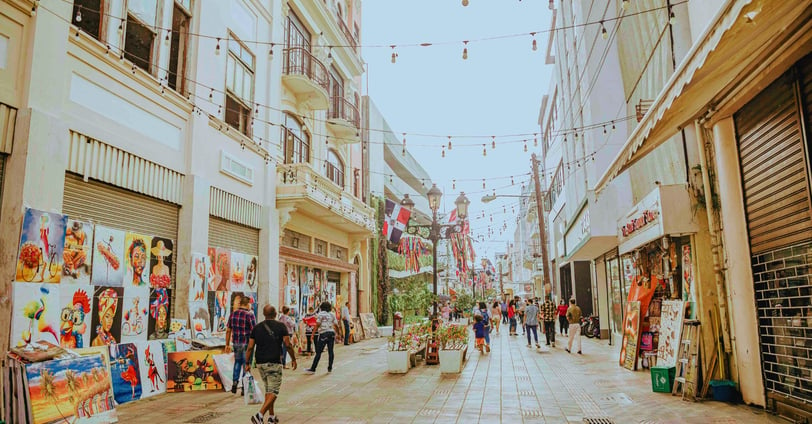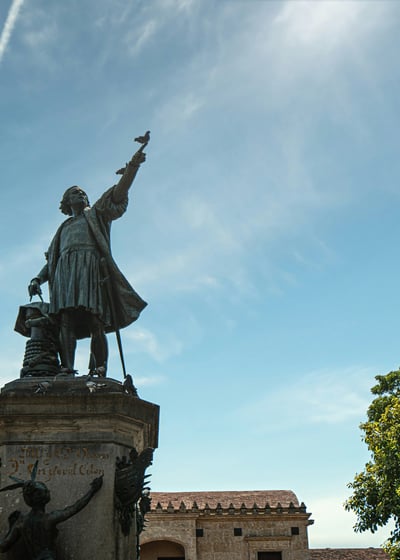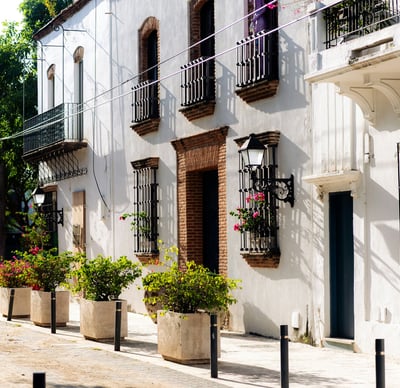The Bookseller of Calle Hostos: A Santo Domingo Tale


The sky over Santo Domingo was the color of old paper when I found the bookshop—folded between a bakery and a crumbling blue doorway on Calle Hostos, an unassuming street historically tied to the heart of the city's colonial past. I hadn’t planned to stop. I was walking slowly to avoid the weight of the heat, drifting without aim past closed shutters and hanging bougainvillea. But the door was open, and inside it was quiet. That was enough.
The place didn’t have a name—at least, not one that I could see. The sign above the door had long since faded, its letters nearly swallowed by layers of time and sea air. But the moment I stepped inside, the smell of old books settled around me like a shawl: musty, papery, and laced with the faintest note of salt.
The woman behind the counter looked up, nodded once, then returned to writing in the margin of a thick volume that looked older than the lamp beside her. She didn’t ask if I needed help, and I was grateful. Some spaces are not meant for interruption.


The shop was small but deep—rows of shelves, some sagging, others reinforced with bricks or stacked dictionaries. Dust danced in the shafts of late afternoon light that cut through slatted windows. Somewhere behind me, a ceiling fan turned lazily, clicking with each rotation like a clock that no longer cared to count time. Calle Hostos, named after Eugenio María de Hostos—a Dominican intellectual and reformist—holds whispers of an era when knowledge and independence intertwined. It's a street that invites curiosity.
Santo Domingo is not a quiet city, but it is layered. The Zona Colonial, where I had wandered in from, carries the echoes of car horns and children’s laughter, of rumbling motoconchos and voices drifting from balconies. There are corners where the noise fades—beneath the arches of the Monasterio de San Francisco, or under the slow sway of trees in Parque Duarte. There are places where music spills out of doorways—soft bachata in the mornings, louder merengue by dusk.
And yet, inside the bookshop, there was only the hush of turning pages.
I wandered without looking for anything, tracing the spines of books with a fingertip. Spanish, French, English. Travel memoirs with cracked leather covers. Forgotten volumes of poetry. Faded encyclopedias that still referred to countries that no longer existed. As I moved among the shelves, it struck me how Santo Domingo's past—like the books here—is composed of fragments waiting to be rediscovered.
Near the back, tucked between a loose floorboard and a stack of unbound papers, I found it: a slim book with a hand-stitched spine, its cover worn soft like sea-smoothed stone. No title. I opened it. Inside, on the first page, in looping ink:
“For the one who stays long enough to listen.”


The pages that followed were not quite diary, not quite story. Fragments. Sketches. Sentences that seemed to end mid-thought. A list of dates. A pressed leaf. A sketch of the Plaza Colón in rain. And, midway through, a line that struck with the hush of something remembered:
"You will know you have arrived when the silence begins to speak."
I read it twice before I realized I was holding my breath.
When I turned, the woman was watching me—not curiously, but with the quiet recognition of someone who’s seen many people come and go, and a few who stayed longer than they meant to.
“Take it,” she said, voice soft as folding cloth. “It was waiting.”
I hesitated. “But it doesn’t belong to me.”
She smiled—gently, as if amused by the idea of ownership. “Maybe not. But it found you.”
I stepped back into the street carrying the book, the air warm and slightly metallic, like rain hadn’t fully left. Down the street, a group of tourists were gathered near the Museo de las Casas Reales, their guide gesturing animatedly toward a row of cannons. I passed them quietly, drawn instead toward the softer edges of the city—the shade beneath the trees at Parque Colón, the stone stillness of the Fortaleza Ozama, and the echoing quiet that lives in the lesser-trodden pathways. Santo Domingo is not solemn, but it remembers. And when it remembers, it does so in whispers.


That evening, I sat on a bench near the ruins of San Francisco Monastery, the book still in my lap. The streets were nearly empty, except for a boy pushing a cart of roasted peanuts, humming to himself. The stones underfoot still held the warmth of day, but the air had shifted. Lighter. Like something had been exhaled.
In the distance, I heard a bell—one of those low colonial bells that seem to ring out not just in time, but in memory. I opened the book again and read:
"He said Calle Hostos had ghosts. I said maybe they were just stories that stayed too long. He said there’s no difference."
I didn’t sleep much that night. Not out of unease, but because something had begun to stir. In the city's quiet moments, Santo Domingo offers spaces that feel eternal—where the weight of history presses lightly but deeply. I kept thinking of the way the woman looked at me—not inviting, not warning—just offering space. As if the shop wasn’t hers. As if the stories inside weren’t hers either. Only held, until they found their next reader.
The next morning, I returned. The bakery was open, the blue doorway unchanged. But the shop’s door was closed, the shutters drawn. I knocked once. Waited. No sound.
An old man sweeping the street nearby paused. “Looking for the librería?”
I nodded.
He smiled, toothless and kind. “It opens when it wants.”
I looked again. The sign above the door was there, after all, barely visible in the morning light. Hand-lettered. Faded but clear enough if you knew what to look for:
“La memoria no necesita prisa.”
Memory is in no hurry.
I never saw the bookseller again. But I still have the book. Sometimes I open it on quiet afternoons and let the pages breathe. And every now and then, a word I hadn’t noticed before appears in the margin, written in ink I don’t remember seeing.
Perhaps it writes itself, in silence.
Or perhaps memory just waits until we’re ready to read it.
Santo Domingo’s layered streets and quiet whispers offer more than memories—they reveal the soul of the first city of the New World. Dive deeper into its historic landmarks and timeless charm in Destinations — "Santo Domingo, Dominican Republic: The First City of the New World."
From the hush of Calle Hostos to the hum of a city transforming, follow the next chapter of Santo Domingo’s living story in Travel Insights — "Santo Domingo 2025: Colonial Echoes, Afro-Caribbean Spirit, and Urban Renaissance."
✉️ Contact:
Curated by TrueTrip Hub |
© 2025 Invisible Atlas — All rights reserved.
Invisible Atlas
Journey Beyond the Visible
invisible.atlas@truetriphub.com
